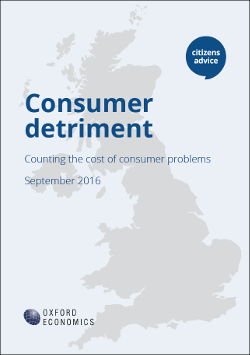Ungated Post | 26 Sep 2016
Consumer detriment: Counting the cost of consumer problems

Every year, millions of UK consumers suffer from some form of consumer detriment, be it a delayed delivery, substandard service or the purchase of a faulty item. Such experiences are a familiar feature of everyday lives, but quantifying the scale and impact of these experiences for UK consumers in a systematic way is a complex task.
This research project takes account of the monetary and time costs of consumer detriment, as well as compensation, to arrive at a considered estimate of total net cost for the UK population. This valuation incorporates three core elements. Firstly, it calculates the direct monetary costs borne by consumers who experience problems. These might be cash outlays caused by the problem itself (for example, when a broken toy is simply written off or when a poorly fitted boiler causes knock-on problems that have further costs) as well as any resulting loss of earnings. Secondly, it calculates the value of any leisure time given up by the consumer in experiencing or attempting to resolve the issue, so-called ‘time costs’, which might include things like time wasted on a delayed train, or time spent in a phone queue to get through to customer services. Thirdly, it calculates any compensation payments awarded in light of any claims made by the consumer, and subtracts these from the monetary and time costs described above. This approach seeks to present a comprehensive picture of UK consumer detriment, both larger and smaller problems.
Oxford Economics’ team is expert at applying advanced economic tools that provide valuable insights into today’s most pressing business, financial, and policy issues.
To find out more about our capabilities, contact:
Americas
Diantha Redd
+1 (646) 503 3052
Email
Asia Pacific
Peter Suomi
+65 6850 0110
Email
EMEA
Aoife Pearson
+44 (0)203 910 8054
Email
Related Services

Post
The economic impact of abandoning the WTO
Oxford Economics have been commissioned by the International Chamber of Commerce (ICC) to provide an independent assessment of the economic impact of WTO dissolution. This report details our findings and the assumptions underpinning our analysis.
Find Out More
Post
The economic impact of the sports activities of public service media
This study shows how the sports activities of public service media supported €4.5 billion of GDP and 57,000 jobs across 31 European countries in 2022. The report also highlights wider economic benefits of public service media sports coverage, such as the way in which it leverages sponsorship income for sports bodies.
Find Out More
Post
Global Trade Education: The role of private philanthropy
Global trade can amplify economic development and poverty alleviation. Capable leaders are required to put in place enabling conditions for trade, but currently these skills are underprovided in developing countries. For philanthropists, investing in trade leadership talent through graduate-level scholarships is an opportunity to make meaningful contributions that can multiply and sustain global economic development.
Find Out More